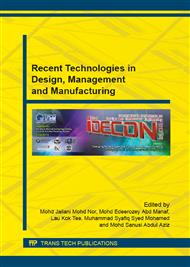p.646
p.651
p.659
p.664
p.668
p.673
p.678
p.683
p.688
Design of an Ergonomic Acquisition and Monitoring Framework in Assembly Task
Abstract:
Optimum working conditions, such as body posture, body movement and working environment are commonly not directly known to the worker. In fact, the worker current working conditions are rarely provided. Although some may find it unnecessary, a mechanism to provide information on this situation is deemed to be useful. This paper presents a proposed framework for acquiring and monitoring ergonomic parameters. There are six potential useful parameters proposed in this study. The parameters include temperature, light, vibration, body posture, indoor air quality, and noise. In the proposed framework, the capturing device and signal converter are regarded as the main components. The framework is proposed to capture all parameters in the analog signal, and later convert it into the digital signal using the signal converter. At this stage, NI cDAQ-9188 is proposed to be used as the signal converter in the framework. The preliminary work of the proposed framework will be developed in the lab, while the implementation will be conducted at the chosen industry. It is hoped that the proposed framework will benefit industry and promote a safe working environment in the industry, especially for assembly tasks.
Info:
Periodical:
Pages:
668-672
Citation:
Online since:
May 2015
Keywords:
Price:
Сopyright:
© 2015 Trans Tech Publications Ltd. All Rights Reserved
Share:
Citation:


